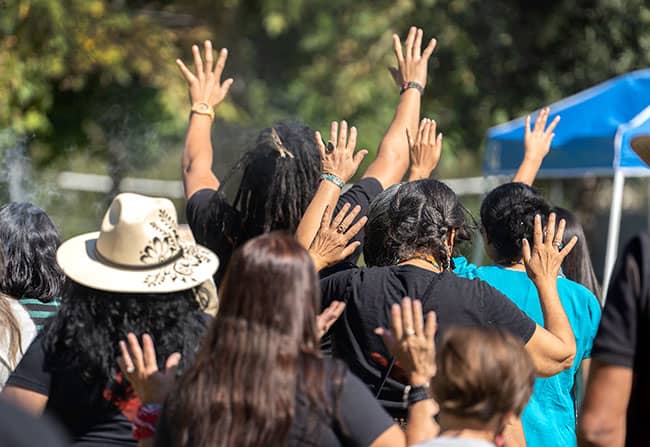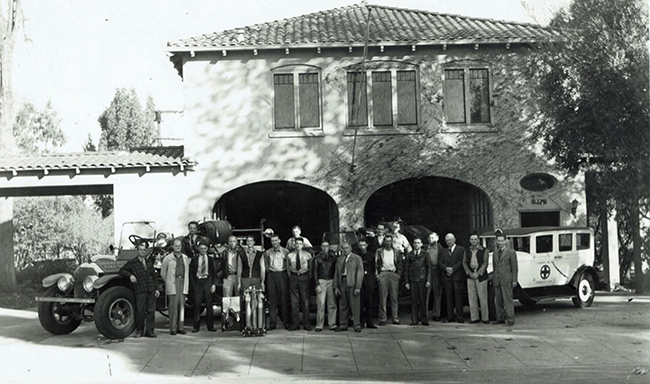OneDrumm brings Indigenous traditions to Claremont

by Andrew Alonzo | aalonzo@claremont-courier.com
On Sunday, Memorial Park was filled with residents seeking insight about Native American history at Claremont’s first annual Indigenous Peoples Day gathering.
The gathering was hosted by OneDrumm — a local nonprofit comprised of Indigenous people who aim to bridge “the gap between cultures through the power of the drum.” The goal for the day was to put Indigenous people’s historic traditions at the forefront for all to experience, according to OneDrumm co-founders Ginger Grant and Sewa Marsha Valencia.
“Anytime that we can bring our people together and share in prayer, to share in good medicine, to share in each other’s traditions and race, it’s a good day. It helps heal our community, it helps heal our peoples, and brings awareness and dialogue so that we can open the door to have a conversation. That’s important, that’s what’s missing — is the conversation, that we are still here and are still a part of your community,” Valencia said.
By 11 a.m., about 20 residents had trickled in. The smell of burning incense, the sounds of Steve Rushingwind’s Native American flute and posters highlighting 37 of today’s prolific indigenous people were just a few things that filled the park that morning.
Processions began when attendees formed a circle around the center of the park, locking hands with one another and sharing in a prayer. The opening prayer and ceremony were led by Michael Negrete, the chief, chairman and medicine man of the Shiishongna Tribe of the Corona Band of Gabrielino Indians.
Rudolph “Singing Byrd” Medina of the Mescalero Apache, and Damon “Yellow Hawk” Bradlay of the Coastal Band of the Chumash Nation walked into the center to play a community song. Side-by-side, repeating the words “hung-ju-wa” as they beat their hand drums, while the community sang along with the pair, growing louder with each repetition of the word.
Fifteen OneDrumm women made their way into the circle center. Valencia thanked all those who came to support Indigenous culture and shared that the only reason she and any of her Native relatives were there was because of the “work, perseverance and resilience” of their ancestors.
The circle disbanded about 25 minutes after forming.

Indigenous women from Claremont’s local non-profit OneDrumm gather together and pray to their ancestors before beginning Sunday’s celebrations of Indigenous People’s Day at Memorial Park. COURIER photo/Andrew Alonzo
Medhane Quetzalcoatl, the emcee for the afternoon, appeared on Memorial Park’s stage and began discussing the struggles and hardships that his ancestors had to overcome due to settlers invading their land. Concluding with a message of love, Quetzalcoatl said he does not hold resentment for the bloody past in his heart, as instead he and other Native Americans only want love to reside there.
As various acts took the stage, attendees took pictures inside a towering teepee nearby, while an adjacent water booth supplied natural Oregon spring water to attendees.
Across from the water booth was an altar honoring Indigenous women who have gone missing or been murdered. Another large teepee sat across from the altar near Eighth Street, occupied by 64-year-old Ed Martinez, a 40-year veteran storyteller from the Pima-Papago tribe of Tucson, Arizona. Next to his teepee a series of canopies shaded art activities ranging from coloring in or knitting “Eyes of God.”
Chief Negrete shared how important Sunday was to him and his ancestors. “It resonates with me dearly, a lot. Every day is Indigenous Day to us, not just one day,” he said.
When asked why communities should get away from calling the day” Columbus Day, “Negrete replied with a question of his own. “When Neil Armstrong, the first man to walk on the moon, did he find the moon? No, the moon was already there, right?” he asked. “It feels good to be recognized. [But] before this was La Verne, Claremont, [et cetera], it was Gabrielino land. This has always been Gabrielino land and … we’ll leave, go to the spirit world with grandfather and this will still be Gabrielino. No matter what, this will stay Gabrielino land.”
Grant also explained the difference between Columbus Day and Indigenous Peoples Day, saying it comes down to a matter of perspective.
“If you want your privilege, you want Columbus because you get to believe that your ancestors were conquerors and they conquered a weaker race and that [Indigenous people] are still running around half dressed …
“This is not something you solve in a day, so [the issue] is deep rooted and deep seeded and we can’t control anybody’s resistance. We own it as Indigenous Day now because we are now in a society and time period where we’re not scared to be Indian. We’re not taking back, but going to restate the truth and this was a truth that needed to be restated,” Grant continued.

Mary Kladouris, bottom right, lights ceremonial incense while Steve Rushingwind, behind, plays his wind flute for spectators during Sunday’s celebration of Indigenous People’s Day at Memorial Park in Claremont. COURIER photo/Andrew Alonzo
Just before 3 p.m., six players from the Los Angeles Tlaltikpak Ulama team offered a demonstration of the game ‘ulama,’ an ancient sport from Mesoamerica that is played by hitting a ball back and forth with the hips until it crosses an opponent’s goal. After a scrimmage, attendees were allowed to get a feel for the game.
As the closing processions began, a medicine drum circle formed, led Valencia and the group of 14 OneDrumm women, who played songs of healing, spirituality, and in honor of missing and murdered Indigenous women. As the group pounded two large ceremonial drums in unison, the community looked on and joined in.
After the ceremony, Grant said, “Many times in our history books, we are in the past. And many don’t see Indigenous people as being something that is happening now.” She added, “Here is one, for people to see us; yes honoring our past traditions, but also bringing forth new traditions that are going to come from our new generations based on the sciences that are available now.”
Valencia she shared that the day did not feature any type of performers or entertainers, just Native Americans sharing their culture with Claremonters.
Throughout the day, some 250 attendees came to learn more about Native American culture, shocking Grant and Valencia. For more information on the nonprofit and their upcoming circles at Pomona College, visit their website at https://www.onedrumm.com.











0 Comments